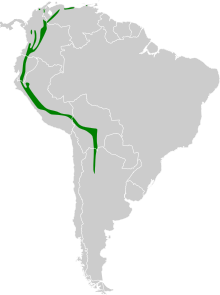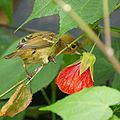
The long-billed partridge is a species of bird in the family Phasianidae.

The white-naped jay is a species of bird in the family Corvidae. It is endemic to Brazil - where it is known as the Gralha Cancã or the Cancão. Its natural habitats are subtropical or tropical dry forest and subtropical or tropical moist lowland forest.
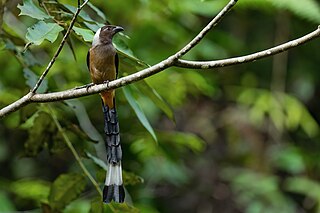
The Sumatran treepie or Sunda treepie is a species of bird in the family Corvidae. It is endemic to the island of Sumatra in Indonesia. Its natural habitats are subtropical or tropical moist lowland forest and subtropical or tropical moist montane forest. The Bornean treepie is sometimes considered to be a subspecies of this bird.

The white-sided flowerpiercer is a fairly common and widespread species of Flowerpiercer. Flowerpiercers are a genus of birds within the Tanager family Thraupidae, with specially adapted bills that enable them to pierce the sides of flower blossoms to access the nectar. The white-sided flowerpiercer is found in Colombia, Ecuador, Peru, and Venezuela. Its natural habitats are subtropical or tropical moist montane forests and heavily degraded former forest.
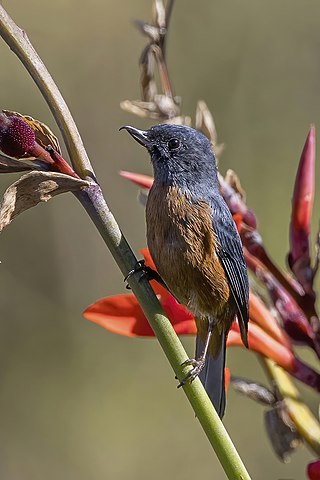
The cinnamon-bellied flowerpiercer is a species of bird in the family Thraupidae. It is found in El Salvador, Guatemala, Honduras, and Mexico.

The black-throated flowerpiercer is a species of bird in the family Thraupidae.

The grey-bellied flowerpiercer is a species of bird in the family Thraupidae. It is found in the Bolivian Andes and far northwestern Argentina.

The scaled flowerpiercer is a species of bird in the family Thraupidae. It is found in the tepuis of Brazil and Venezuela.

The Mérida flowerpiercer is a species of bird in the family Thraupidae. It is endemic to Venezuela.

The chestnut-bellied flowerpiercer is a species of bird in the family Thraupidae. It is endemic to Colombia.
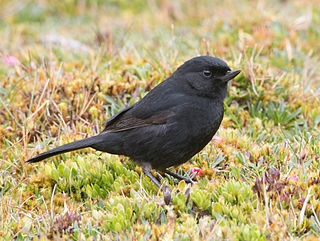
The black flowerpiercer is a species of bird in the family Thraupidae of the order Passeriformes. The family Thraupidae is known for tanagers and other very similar species of birds, but it is still facing classification issues. The black flowerpiercer is found in Colombia, Ecuador, Peru, and Venezuela.

The glossy flowerpiercer is a species of bird in the family Thraupidae. It is found in Colombia, Ecuador, Peru, and Venezuela.
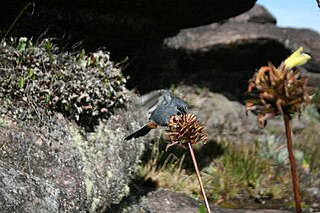
The greater flowerpiercer is a species of bird in the family Thraupidae. It is found in the tepuis of western Guyana, eastern Venezuela and far northern Brazil. Its natural habitats are subtropical or tropical moist montane forests and subtropical or tropical high-altitude shrubland.
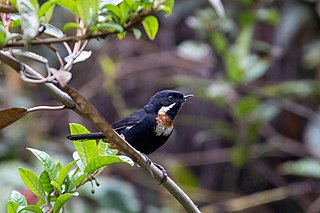
The moustached flowerpiercer is a species of bird in the family Thraupidae. It was first described by French ornithologist Frédéric de Lafresnaye in 1846. It is found in Bolivia and Peru. Its natural habitats are subtropical or tropical moist montane forests, subtropical or tropical high-altitude grassland, and heavily degraded former forest.

The Venezuelan flowerpiercer is a species of bird in the family Thraupidae. It is endemic to Venezuela.

The olive bushshrike is a species of bird in the family Malaconotidae. It is found in Malawi, Mozambique, South Africa, Eswatini, and Zimbabwe. Its natural habitats are subtropical or tropical dry forest, subtropical or tropical moist lowland forest, subtropical or tropical moist montane forest, and subtropical or tropical dry shrubland.
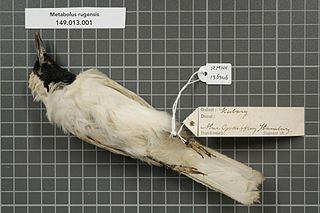
The Chuuk monarch, or Truk monarch, is a species of bird in the family Monarchidae. It is monotypic within the genus Metabolus. It is endemic to the island of Chuuk in Micronesia.

The black-bibbed monarch is a species of bird in the family Monarchidae that is endemic to Indonesia. It is found in the Tanimbar Islands. Its natural habitats are subtropical or tropical moist lowland forests and subtropical or tropical mangrove forests.

The southern martin is a species of bird in the family Hirundinidae.
Axinaea sclerophylla is a species of tree in the family Melastomataceae. It is endemic to Ecuador, where its natural habitat is subtropical or tropical moist montane forests.

